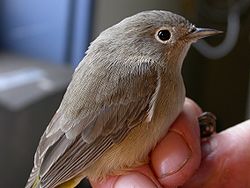- Virginia's Warbler
-
Virginia's Warbler Virginia's Warbler (female) Conservation status Scientific classification Kingdom: Animalia Phylum: Chordata Class: Aves Order: Passeriformes Family: Parulidae Genus: Oreothlypis Species: O. virginiae Binomial name Oreothlypis virginiae
(Baird, 1860)Virginia's Warbler (Oreothlypis virginiae) is a species of New World warbler.
Despite what its name may suggest, Virginia's warbler is not actually named after the American State of Virginia, which makes sense as the birds range only reaches as far east as the state of Texas. The bird's common eastern range is central and southern mountains of Colorado, central Wyoming, and central and western New Mexico. The bird was named for Virginia Anderson, the wife of an army surgeon who discovered the bird at Fort Burgwin, New Mexico, in 1858. When Spencer Fullerton Baird of the Smithsonian Institution fully described the bird for science in 1860 he honored the wishes of the warbler's discoverer and designated Virginia to be both the bird's common and scientific name.
Virginia's warbler is a small bird, only 4 to 4½ inches in length. It is mainly gray in color, with a lighter colored under-belly and a white eye ring. The rump and undertail coverts are yellow. Males also have a yellow patch on their breast and a red cap, both of which are lacking in female and immature birds. Virginia's warbler can be easily mistaken for the Colima Warbler, but it is smaller and has a more yellow rump.
Contents
Life history
Virginia's warbler is common in dense oak and pinyon woodlands and brushy streamside hills at altitudes ranging from 6,000–9,000 ft (1,800–2,700 m). It summers in the south-western United States and will migrate as far south as Belize during the winter, as well as stopping in several Caribbean islands such as the Bahamas, Cuba, and the Turks and Caicos Islands.
Nests are built on the ground, hidden amongst dead leaves and tufts of grass at the base of a shrub or young tree. The nest is cup-shaped and constructed from moss, grass, strips of bark, and roots. The female will lay between three to five eggs, which are white in color and dotted with fine brown speckles. Young are attended to by both sexes, but incubation period and other nesting habits are mostly unknown.
References
- BirdLife International (2004). Vermivora virginiae. 2006. IUCN Red List of Threatened Species. IUCN 2006. www.iucnredlist.org. Retrieved on 12 May 2006. Database entry includes justification for why this species is of least concern
- Vermivora virginiae, ITIS Report
Further reading
Books
- Olson, C. R., and T. E. Martin. 1999. Virginia’s Warbler (Vermivora virginiae). In The Birds of North America, No. 477 (A. Poole and F. Gill, eds.). The Birds of North America, Inc., Philadelphia, PA.
Thesis
- Conway, Courtney Joseph, Ph.D., (1998) Ecological and physiological constraints on avian incubation behavior and nest-site selection. University of Montana, 149 pages.
Articles
- Berry ME & Bock CE. (1998). Effects of habitat and landscape characteristics on avian breeding distributions in Colorado foothills shrub. Southwestern Naturalist. vol 43, no 4. p. 453-461.
- Howard P. (1999). Virginia's Warbler at Kennesaw Mountain, Cobb County, Georgia. Oriole. vol 64, no 1-2. p. 5-6.
- Martin PR & Martin TE. (2001). Behavioral interactions between coexisting species: Song playback experiments with wood warblers. Ecology. vol 82, no 1. p. 207-218.
- Martin PR & Martin TE. (2001). Ecological and fitness consequences of species coexistence: A removal experiment with wood warblers. Ecology. vol 82, no 1. p. 189-206.
- Sedgwick JA. (1987). Avian Habitat Relationships in Pinyon-Juniper Woodland. Wilson Bulletin. vol 99, no 3. p. 413-431.
- Swanson DL, Palmer JS, Liknes ET & Dean KL. (2000). A breeding population of Virginia's warblers in the southwestern Black Hills of South Dakota. Southwestern Naturalist. vol 45, no 1. p. 39-44.
- Voelker, Gary and Sara L McFarland. (2002) Molt patterns and molting grounds of Lucy's and Virginia's Warblers: Similar yet different. The Wilson Bulletin. Vol 114, no 2. p. 255 (9 pages).
External links
- Virginia's Warbler photo gallery VIREO
- Vermivora virginiae, Discover Life
- Vermivora virginiae, Birds of North America
- Vermivora virginiae, Audubon
- Vermivora virginiae, Audubon
Categories:- IUCN Red List least concern species
- Oreothlypis
- Native birds of the Southwestern United States
- Birds of the Great Basin desert region
- Birds of Mexico
- Native birds of Southern Mexico
- Migratory birds of Southern Mexico
- Birds of Belize
- Birds of Guatemala
- Birds of the Bahamas
- Birds of the Turks and Caicos Islands
- Western North American migratory birds
- Birds of North America
Wikimedia Foundation. 2010.


